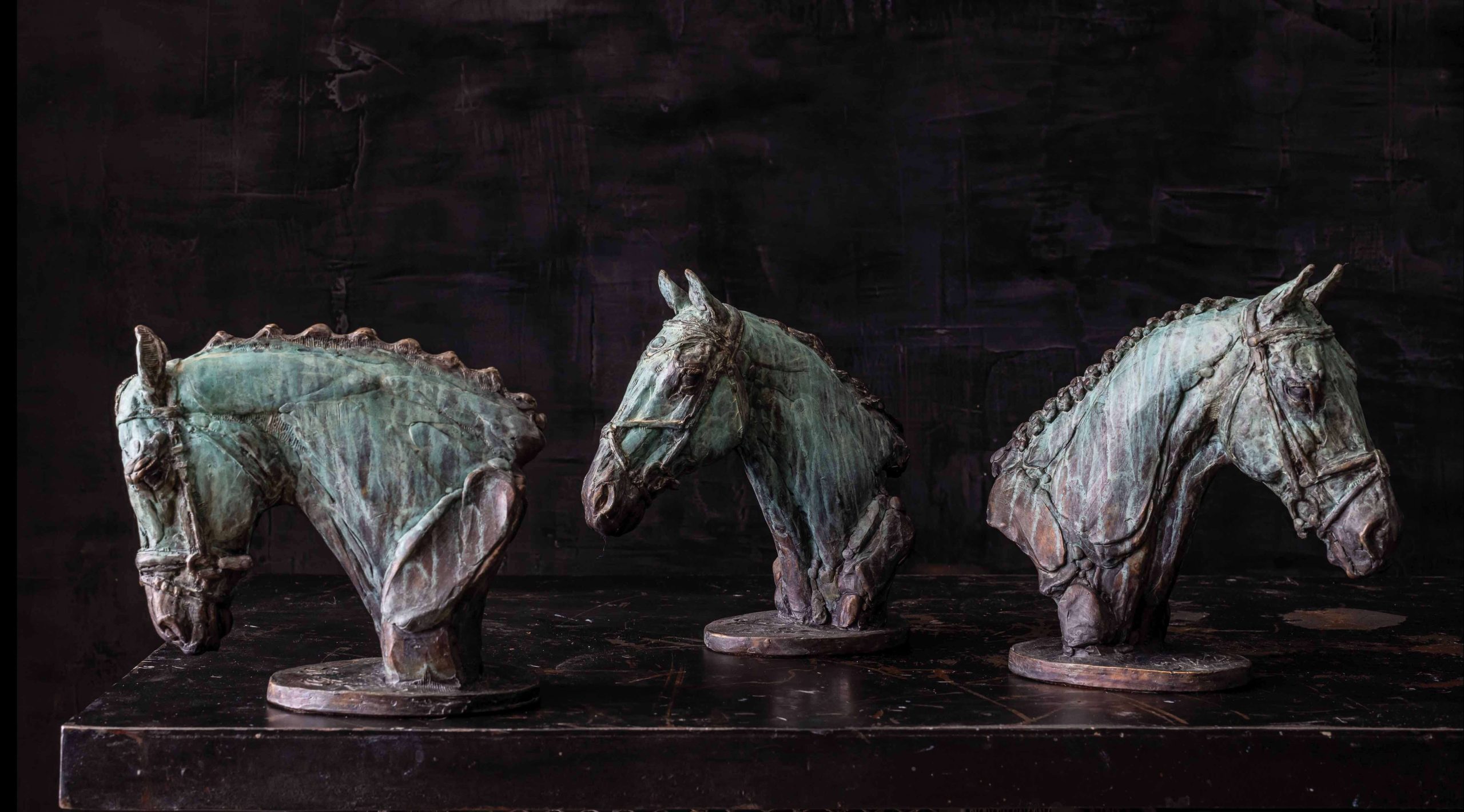
01 Aug A New Era of Bronze in the American West
Great art can seem transcendent, as though it was born from some higher dimension that most of us can’t quite reach. But talking with Stephanie Revennaugh, an award-winning sculptor and equestrian based in Livingston, Montana, feels like returning to earth.
“I think people have this vision of artists, like we’re just sitting around drinking wine, you know, la-de-da, easily creating,” says Revennaugh. She sits across from me in a crowded Livingston café, sipping a cup of coffee. “That romanticism is how our career is portrayed. But in reality, [being an artist] is hardly ever whimsical.”
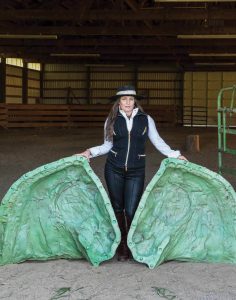
Artist Stephanie Revennaugh poses with a wax mold used in making her signature equine bronze sculptures.
This is especially true for Revennaugh, whose go-to mediums — bronze and, more recently, glass — are highly technical. Creating her bronze sculptures takes multiple steps and leaves dizzying room for error. “I make my sculpture in clay. Then the rest happens.” The clay goes into a mold, and the mold gets filled with wax. The resulting wax sculpture is cut into segments, and each one is cast in bronze. Revennaugh has to weld the bronze segments back into a complete form. All in all, “there are so many opportunities for the form to get really wonky.”
But however relatable Revennaugh may seem when discussing her art, her work remains distinctly otherworldly. She molds her sculptures of horses, bison, and other animals with an impressionistic hand that endows each bronze form with a remarkable liveliness.

Con Brillo | BRONZE | 55 X 36 X 15 INCHES
As a medium, bronze has played an essential role in Western American art. Artists Frederic Remington [1861 – 1909] and Charles M. Russel [1864 – 1926] sculpted action-packed bronze scenes of life on the American frontier, glorifying visions of dominance and survival. But contrary to her predecessors, Revennaugh approaches her subjects with a reverent singularity, focusing on the animals’ emotions and mindset. Revennaugh’s intimate relationship with her subjects and nuanced approach to the medium feel like a breath of fresh air, moving the canon forward with striking layers of complexity. “Stephanie’s sculptures capture the true spirit of the horse,” says Lindsey McCann Jastram, owner and director of Old Main Gallery in Bozeman, Montana. “From a gentle downturn of the head to a nuzzle between friends, her work leaves the viewer feeling a connection with the piece unlike any other.”
To understand Revennaugh’s journey as an artist, you first must understand her love for horses. “I was born with an affliction,” she jests. “Playing with my Breyer horse collection is one of my earliest memories.”
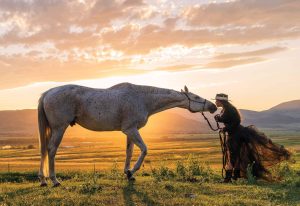
Revennaugh shares a moment with her horse, Mo, in Paradise Valley, Montana.
On her seventh birthday, Revennaugh’s family moved to a house in the hills of Ohio. In a stroke of luck, their new neighbors boasted expansive acreage and a horse, generously allowing her to indulge her passion. Revennaugh recalls idyllic days exploring the surrounding valleys on horseback, only coming home when her mom blew a whistle for dinner. There were also moments of audaciousness — leaping from the back of one horse to the next, occasionally meeting the ground with an undignified thud. “Us kids, we were nearly feral — we’d often ride bareback. But there was so much freedom,” says Revennaugh.
Slowly, horses became Revennaugh’s career. She pursued formal equitation training in her teens, which led to competitive jumping before steering her toward work at English riding barns. “It was a lot of work, a bit of riding,” says Revennaugh. In her early 30s, she landed a dream job managing a dressage barn in Evergreen, Colorado. She lived alone on the property, in a log cabin with a view of the mountains and a lake beyond. It was her own “slice of heaven.” But achieving the dream also forced her to take stock of where she wanted to go next. “It was like I had reached the pinnacle,” says Revennaugh, “like I was no longer in that survival mode. And in that space, I had time to sit down and think, ‘What is it I actually want to be doing with my life?’”
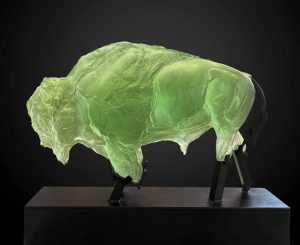
Portent | GLASS | 17 X 17 X 4 INCHES
The answer was art, she realized. Revennaugh had always been interested in art but had stopped herself from considering a career as an artist. A sculpture class in college had left a bad taste in her mouth. “The instructor wanted us to focus on abstract forms, which didn’t interest me — I dropped the course after a single class,” says Revennaugh. “All I wanted to do was sculpt horses. And I felt like art school wouldn’t give me that freedom. So, I just rejected [the idea of becoming an artist].” But in her period of self-evaluation, Revennaugh reconsidered her rejection. “I realized, if I didn’t give [a career in art] 100 percent, I’d regret it. I had to at least try it. Maybe I’d fail, but I had to give it my all and see if it worked,” says Revennaugh.
She started taking art classes in Colorado, studying under established painter Don Sahli — a former student of Ukrainian American expressionist painter Sergei Bongart. Then came an opportunity to attend a painting course in Aix-en-Provence, France, the birthplace of famed Post-Impressionist painter Paul Cézanne. “I knew I wanted to immerse myself in art, and I had never been to Europe,” says Revennaugh. She took a risk and quit her steady job at the barn, a decision that turned out to be a blessing in disguise. “I burnt the ships,” says Revennaugh. “I had nothing to return to, which left me no choice but to go forward with my art.” To fully commit herself to the process, Revennaugh also cut herself off from horses — both as a pastime and an artistic subject. “The last thing I wanted was to limit myself, to put in the work only to become just another mediocre horse painter.”
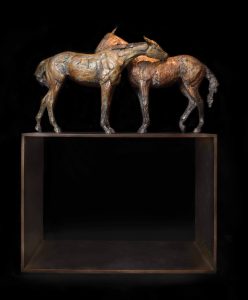
Mutual | BRONZE | 63 X 53 X 18 INCHES
But, in a stroke of bad luck — or, as Revennaugh describes it, “a scene from the satirical film Art School Confidential” — the instruction in France wasn’t the best. Or at least, it wasn’t what Revennaugh needed at that point in her career. “I was in my 30s, surrounded by a bunch of 19-year-olds waxing poetic about art theory,” Revennaugh says with a smirk. “It wasn’t what I was looking for.” The disappointment was motivating, a moment of stark clarity: “What I learned was going to France won’t make me an artist. This is all up to me.”
Back in the U.S., she devoted herself to creating and selling her paintings until she’d saved enough money to sign up for another art course, this time focusing on sculpture. The moment she touched clay during the first class, something clicked. “I knew immediately this was my medium. And I didn’t hold myself back from making the horse my subject,” says Revennaugh.
Her experience as a painter benefited her approach to sculpting. “I’m grateful. If I hadn’t gone through all the trials and errors with painting, I wouldn’t approach the clay like I do. I treat the clay like brushstrokes,” says Revennaugh. “I know that if I had started with sculpture instead of painting, I wouldn’t have gotten to that more impressionistic style.” The course instructor was Rod Zullo, a sculptor from Bozeman. Learning from him was a key moment in her growth as an artist. “He was offering another course in Big Timber, Montana, so I followed him. And coming here, I immediately fell in love with Montana.” Revennaugh now counts Zullo as one of her biggest influences, alongside renowned sculptors Antoine-Louis Barye and Rembrandt Bugatti.

Untitled, unique piece in a series | CAST GLASS & STEEL | 12 X 18 X 4 INCHES
Revennaugh’s sculptures capture instances of animals in poignant emotional states of rest and unrest, total relaxation and taut focus. Observe the contrast between Mutual and Con Brillo. In the former, two horses gently meet in an intimate, loving moment of recognition. The scene feels private and personal — like happening upon best friends hugging on a park bench. Revennaugh’s hand fills the scene with movement; the horses seem ready to swish their bronze tails at any moment. Con Brillo has the same infusion of animation but imparts a different emotion to the viewer: the subject emanates total concentration, muscles straining. Both works wholly immerse you in the animals’ emotions, taking you out of yourself and into the horse’s psyche. The effect is a bit mystical.
“Her work is just incredibly well done,” says Thomas Cushman, owner and director of Gallery MAR Carmel in Carmel-by-the-Sea, California, one of Revennaugh’s representing galleries. “It’s this really wonderful mix of contemporary and representational. The anatomy, the musculature of her figures — it’s just really, really well done.”
Revennaugh has recently found herself playing with subject and medium, juxtaposing glass and steel. Portent beautifully captures her evolving style. Revennaugh cast a bison in glass, then cut off the legs and tail — replacing them with minimalist steel, adding an unexpected touch of the abstract to her style. “I hate the word ‘juxtaposition;’ it’s overused. But it’s really the best one to describe what I’m doing,” says Revennaugh with a laugh. “I’m experimenting with the duality of organic and inorganic form, bringing these two disparate parts together to find the unexpected continuity and flow.”

Bijou and Chloe | BRONZE | 4.5 X 9 X 3 INCHES
Her evolving style has given Revennaugh a sense of renewal, recentering her creativity and purpose. “I’m at a place in my career where I’m allowing my subconscious to play in the ‘flow’ state,” Revennaugh says. “[An artist] must align the heart and mind to take dreamlike ideas and make them real, visible, and knowable, and then share them with the world in an unspoken language.”
Halina Loft is a writer and editor based in Bozeman, Montana. Before moving west, she worked as an arts editor for Sotheby’s in New York City.
Visual artist Audrey Hall is known for her poignant landscapes, evocative images of wild places, and luxurious interiors. Her art is part of the TIA Collection, whose unique purpose is lending significant works to museums and institutions. She brings the rigor of her fine arts and architectural background to the challenges of creativity, resulting in a growing collection of celebrated books, features, and creative projects.




John Keeling
Posted at 02:50h, 08 AugustWonderful article. I love Stephanie’s work, especially the bronze. Such a fresh take on western imagery. And reading this has prompted me to resubscribe to the magazine.